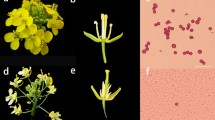Abstract
Oenothera villaricae Dietrich and Oe. picensis Dietrich, complete translocation heterozygotes, are fully interfertile, giving rise to six discrete classes of true-breeding hybrids from a reciprocal cross. Associated with each parent and hybrid is a characteristic abortive non-staining pollen fraction easily distinguished from fully developed pollen under the light microscope. Pollen abortion has been associated with translocation rings in other angiosperm species, and may characterize such systems. The abortive pollen fraction is significantly different between reciprocal Oenothera hybrids, however (P<0.001), indicative of partial cytoplasmic control. Pollen abortion is most severe in the F1 hybrid generation, and ameliorates with successive generations of hybrid self-fertilization. Three-way analysis of variance shows significant effects on pollen stainability (a measure of the non-abortive fraction) for nucleus, cytoplasm and selfed hybrid generation, individually or in combinations. This result suggests a combined nucleocytoplasmic basis for the pollen abortion. Correlated with the observation of increased pollen abortion in Oenothera hybrids are meiotic findings of broken chromosome rings (chains, univalents), asymmetric anaphase chromosome distributions and trinucleate tetrads. To test the hypothesis that such anomalous meiotic events play a role in the mechanism of pollen abortion, meiotic disjunction frequency was determined for each parent, F1 and F9 selfed hybrid accessions. Three-way analysis of variance shows levels of significance comparable to those noted for pollen stainability (P<0.001) for effects of nucleus, cytoplasm and selfed hybrid generation on disjunction frequency. A high degree of correlation (r 2=0.984) is noted between disjunction frequency and pollen stainability. We conclude that the abortive pollen grains are indeed the products of nondisjunctional meiotic events, which themselves are consequences of hybrid nucleocytoplasmic incompatibility.
Similar content being viewed by others
Author information
Authors and Affiliations
Additional information
Received: 28 May 1997 / Revision accepted: 23 July 1997
Rights and permissions
About this article
Cite this article
Chapman, M., Mulcahy, D. Effect of genome-plastome interaction on meiosis and pollen development in Oenothera species and hybrids. Sex Plant Reprod 10, 288–292 (1997). https://doi.org/10.1007/s004970050100
Issue Date:
DOI: https://doi.org/10.1007/s004970050100




